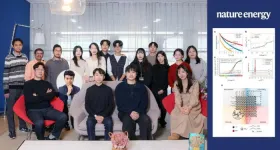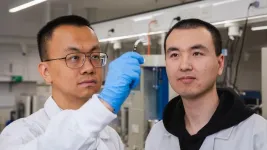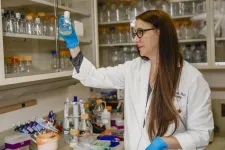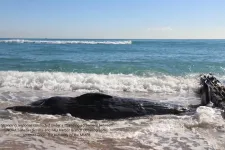(Press-News.org) A groundbreaking research breakthrough in solar energy has propelled the development of the world’s most efficient quantum dot (QD) solar cell, marking a significant leap towards the commercialization of next-generation solar cells. This cutting-edge QD solution and device have demonstrated exceptional performance, retaining their efficiency even after long-term storage. Led by Professor Sung-Yeon Jang from the School of Energy and Chemical Engineering at UNIST, a team of researchers has unveiled a novel ligand exchange technique. This innovative approach enables the synthesis of organic cation-based perovskite quantum dots (PQDs), ensuring exceptional stability while suppressing internal defects in the photoactive layer of solar cells.
“Our developed technology has achieved an impressive 18.1% efficiency in QD solar cells,” stated Professor Jang. “This remarkable achievement represents the highest efficiency among quantum dot solar cells recognized by the prestigious National Renewable Energy Laboratory (NREL) in the United States.”
The increasing interest in related fields is evident, as last year, three scientists who discovered and developed QDs, as advanced nanotechnology products, were awarded the Nobel Prize in Chemistry. QDs are semiconducting nanocrystals with typical dimensions ranging from several to tens of nanometers, capable of controlling photoelectric properties based on their particle size. PQDs, in particular, have garnered significant attention from researchers due to their outstanding photoelectric properties. Furthermore, their manufacturing process involves simple spraying or application to a solvent, eliminating the need for the growth process on substrates. This streamlined approach allows for high-quality production in various manufacturing environments.
However, the practical use of QDs as solar cells necessitates a technology that reduces the distance between QDs through ligand exchange, a process that binds a large molecule, such as a ligand receptor, to the surface of a QD. Organic PQDs face notable challenges, including defects in their crystals and surfaces during the substitution process. As a result, inorganic PQDs with limited efficiency of up to 16% have been predominantly utilized as materials for solar cells.
In this study, the research team employed an alkyl ammonium iodide-based ligand exchange strategy, effectively substituting ligands for organic PQDs with excellent solar utilization. This breakthrough enables the creation of a photoactive layer of QDs for solar cells with high substitution efficiency and controlled defects.
Consequently, the efficiency of organic PQDs, previously limited to 13% using existing ligand substitution technology, has been significantly improved to 18.1%. Moreover, these solar cells demonstrate exceptional stability, maintaining their performance even after long-term storage for over two years. The newly-developed organic PQD solar cells exhibit both high efficiency and stability simultaneously.
“Previous research on QD solar cells predominantly employed inorganic PQDs,” remarked Sang-Hak Lee, the first author of the study. “Through this study, we have demonstrated the potential by addressing the challenges associated with organic PQDs, which have proven difficult to utilize.”
“This study presents a new direction for the ligand exchange method in organic PQDs, serving as a catalyst to revolutionize the field of QD solar cell material research in the future,” commented Professor Jang.
The findings of this study, co-authored by Dr. Javid Aqoma Khoiruddin and Sang-Hak Lee, have been published online in Nature Energy on January 27, 2024. The research was made possible through the support of the ‘Basic Research Laboratory (BRL)’ and ‘Mid-Career Researcher Program,’ as well as the ‘Nano·Material Technology Development Program,’ funded by the National Research Foundation of Korea (NRF) under the Ministry of Science and ICT (MSIT). It has also received support through the ‘Global Basic Research Lab Project.’
Journal Reference
Havid Aqoma, Sang-Hak Lee, Imil Fadli Imran, et al., “Alkyl ammonium iodide-based ligand exchange strategy for high-efficiency organic-cation perovskite quantum dot solar cells,” Nature Energy (2024).
END
Revolutionary breakthrough in solar energy: World’s most efficient QD solar cells developed
2024-02-21
ELSE PRESS RELEASES FROM THIS DATE:
New water batteries stay cool under pressure
2024-02-21
A global team of researchers and industry collaborators led by RMIT University has invented recyclable ‘water batteries’ that won’t catch fire or explode.
Lithium-ion energy storage dominates the market due to its technological maturity, but its suitability for large-scale grid energy storage is limited by safety concerns with the volatile materials inside.
Lead researcher Distinguished Professor Tianyi Ma said their batteries were at the cutting edge of an emerging field of aqueous energy storage devices, with breakthroughs that significantly improve the technology’s performance and lifespan.
“What ...
Focus on patient experience can improve diabetes care
2024-02-21
WASHINGTON—Health care providers who treat diabetes need to think beyond the clinical numbers, such as solely focusing on a person’s glucose goals. Taking the patient experience into account can improve the quality of care and facilitate attainment of treatment goals, according to a new position statement published in the Endocrine Society’s Journal of Clinical Endocrinology & Metabolism.
The position statement reflects the consensus of two virtual roundtables the Endocrine Society held in 2022. Participants ...
KIER’s success in the development of the world's top-level semi-transparent perovskite solar cells
2024-02-21
The Photovoltaics Research Department of the Korea Institute of Energy Research (hereafter KIER), working with the KIER Energy AI and Computational Science Lab, has achieved advancements in the stability and efficiency of semi-transparent perovskite solar cells. These cells have potential use in building windows and tandem solar cells*. The semi-transparent solar cells achieved a record-breaking efficiency of 21.68%, making them the most efficient amongst the perovskite solar cells using transparent electrodes in the world. Additionally, they showed ...
NIH grant to aid Rumbaugh’s biofilm dispersal research
2024-02-21
Most chronic wound infections share one thing in common: the presence of biofilms, which are composed of many different microorganisms that congregate as a mass, usually on some type of surface such as a wound bed. Biofilms are thought to be associated with up to 80% of infections, and their ability to stick together makes the biofilm and infection exceptionally difficult to kill.
To combat this health care challenge, researchers such as Kendra Rumbaugh, Ph.D., a professor in the Texas Tech University Health Sciences Center (TTUHSC) School of Medicine’s Department of Surgery, are pursuing biofilm dispersal agents such as ...
Study details toxic elements found in stranded whales, dolphins over 15 years
2024-02-21
Whales and dolphins get their nutrients and essential elements through their diet. While eating fish, squid, octopus, crustaceans and other marine mammals, they are also exposed to heavy metal contaminants.
Elevated levels of toxins have been found in stranded dolphins and whales along the Southeastern Coast of the United States. Monitoring toxic contaminants in these stranded marine animals, which serve as important sentinels of environmental contamination, and whose health may be linked to human health, is vital.
Yet, data remain sparse on how specific elements are distributed within an animal’s body, especially for many rarely encountered ...
Inaccurate pulse oximeter readings could limit transplants, heart pumps for Black patients with heart failure
2024-02-21
Racially biased readings of oxygen levels in the blood using pulse oximeters may further limit opportunities for Black patients with heart failure to receive potentially lifesaving treatments, such as heart pumps and transplants, a Michigan Medicine study finds.
“This is especially important because we know that Black patients are already less likely to receive heart pumps or transplants compared to their white counterparts, and these inaccurate readings can further widen a disparity that must be addressed by our health care system,” said first author Scott W. Ketcham, M.D., a third year ...
An awkward family reunion: Sea monsters are our cousins
2024-02-21
KANSAS CITY, MO—February 21, 2024—The sea lamprey, a 500-million-year-old animal with a sharp-toothed suction cup for a mouth, is the thing of nightmares. A new study from the Stowers Institute for Medical Research discovered that the hindbrain—the part of the brain controlling vital functions like blood pressure and heart rate—of both sea lampreys and humans is built using an extraordinarily similar molecular and genetic toolkit.
Research from the lab of Investigator Robb Krumlauf, Ph.D., published on February 20, 2024 in Nature Communications offers a glimpse into how the brains of ancient animals evolved. The team unexpectedly uncovered that ...
Highways through historically redlined areas likely cause air pollution disparities today
2024-02-21
As part of the New Deal, several governmental programs were created to expand homeownership through mortgages and loans. However, neighborhoods with primarily Black or immigrant communities often were rated “hazardous” for repayment under the discriminatory, “redlining” practice that restricted lending. Today, those same areas are exposed to more air pollution than other urban neighborhoods, and according to research published in ACS’ Environmental Science & Technology, the cause could ...
Mercury levels in tuna remain nearly unchanged since 1971, study says
2024-02-21
Tuna is one of the most popular seafoods worldwide. But this protein-rich fish can build up high levels of methylmercury from feeding on contaminated prey, like smaller fish or crustaceans. Despite efforts to reduce mercury emissions into the environment, researchers report in ACS’ Environmental Science & Technology Letters that levels in tuna appear to be unchanged since 1971. They warn that more aggressive emission reduction targets are needed to start nudging down tuna mercury levels.
Environmental ...
Compounds in female ginseng could lead to new osteoporosis treatments
2024-02-21
With ever-increasing life expectancy comes the challenge of treating age-related disorders such as osteoporosis. Although there are effective drugs for treating this metabolic bone disease, they can be expensive and have side effects, limiting their availability to some people. In the search for alternative drug candidates, researchers reporting in ACS Central Science have discovered and fully replicated a compound from a botanical source, female ginseng, that had potent anti-osteoporotic activity in cellular tests.
Osteoporosis and low bone mass impact 54 million American ...





